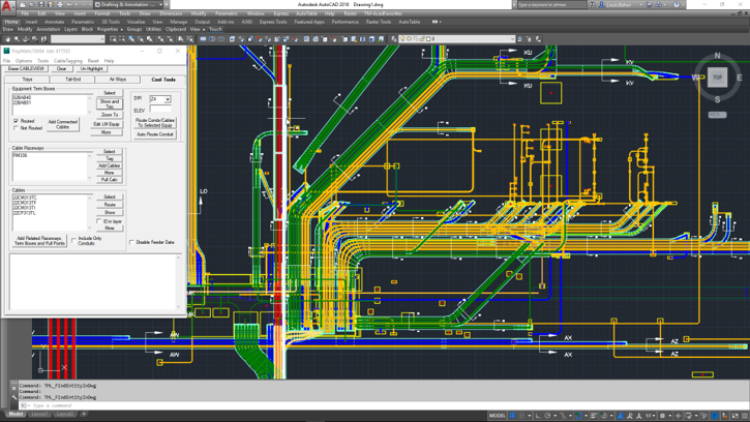Learn Ultimate Electrical Design & Power Engineering Course with Industry Experts!
🚀Boost your career in Oil & Gas, Chemical, Power and other engineering sector.🚀
Course Highlights
- 120+ Hours Masterclass Live Training
- Training Mode: Online Live / Offline
- Batch Type: Regular / Only Sunday
- Regular Assignments / Projects
- Experienced Instructor from Industry
- Provide Study Materials and Case Studies
- Access - Recordings Sessions
- Completion Certificate
- 100% Placement Assistance
Discount Available Up To 25%*
What you'll learn in this course:
Basic Engineering

Sizing, Selection and Calculation of Electrical Equipment: Motor, Transformer, DG Set, Cable, Switch gear, Illumination, etc.
Detail Engineering

Electrical Plant Layout – Cable Routing, SLD, Earthing & Lightning Protection Layout, Lighting Layout, Substation Layout, etc.
Power System Studies

Power Engineering: Load Flow Analysis, Short Circuit Analysis, Motor Starting Study, Relay Coordination, etc.
Requirements:
- PC / Laptop: Core i3 / 256 SSD / 8GB RAM
- System Studies Tool, DiaLux and AutoCAD
- Basic Knowledge of Electrical Engineering
Who is this course for:
- B.E. / B.Tech. / M.E. / M.Tech in Electrical Engineering
- Diploma in Electrical
- Electronics / Instrumentation Engineer
Instructors:

Vinay Sir (16+ Years of Experience)
- Electrical Equipments / Material– Design, Procurement / technical specifications & Detail engineering
- Equipment sizing, Calculation and Selection
- Preparation of Technical specification, data sheets and procurement activities
- Relay Co-ordination, voltage drop calculation, fault level analysis
- Cable sizing, Earthing sizing and lighting calculation
- Preparation /review electrical engineering studies, reports & calculation, Load list
- Substation equipment layout, Lighting and earthing layout
- Preparation of tender documents (SOR/BOQ) for site erection/activities
- Coordinating design activities with other -discipline project team members

Vishal Sir (10+ Years of Experience)
- Preparation of Electrical load list & load calculation.
- Electrical equipment sizing (Transformer, Switchgears, etc.)
- Preparation of cable list, cable drum schedule, conduit schedule
- Power system studies (Load flow, Short circuit studies, Harmonic analysis, Motor starting study)
- Preparation of technical specification and data sheet of various Electrical equipment
- Vendor offer, technical queries & technical bid evaluation of electrical equipment (Variable Speed drive, Switchgears, Motors, Generators)
- Interconnection diagram (Motors, Generators, etc.)
- Layouts (Cable routing & power layouts)
Curriculum:
Electrical Design Engineering
- Introduction of Electrical Engineering
- Introduction of EPC Industry
- Coordination with Other Department
- Preparation of Load Schedule
- Determination of Power Supply Capacity
- Standby Capacity consideration
- Rating of Generators in Relation to Prime Movers Importance of max and min temp
- Rating of Motors in Relation to their Driven Machines
- Motor
- Transformer
- Emergency Generator
- Neutral Grounding Resistor (NGR)
- Power capacitor banks (PCB)
- AC UPS
- HV/MV Switchgears
- LV Switchgears
- Battery
- Battery Charger
- DC UPS
- CT/PT
- Power reactor
- Bus duct
- Introduction
- Type of Lighting Fixtures
- Selection of Lighting Fixtures
- Preparation of Fixtures Schedule
- Indoor Illumination Calculation
- Outdoor Illumination Calculation
- Calculation on Software
- Lighting Layout Design
- Lighting Installation Detail
- Small Power selection
- Lighting Board Schedule
- Power and Control cable Introduction
- Cable Selection and Sizing
- Cable sizing for Low voltage system
- Cable sizing for High voltage system
- Voltage Drop Consideration
- Let through Energy consideration
- Earth fault Loop Impedance consideration
- Cable Schedule
- Cable interconnection Schedule
- Selection and Sizing of cable Tray
- Cable tray schedule
- Cable Drum schedule
- Conduit Selection
- Conduit Sizing
- Cable Routing Layout
- Cable Tagging
- Installation details
- Introduction
- Type of Sub-Stations
- General arrangement of substation
- Equipment Layout
- Key SLD
- Detail SLD
- Lighting system SLD
- Small power SLD
- Metering and Control diagram
- Zone/Division Classification
- Types of Protection for Hazardous Areas
- Hazardous source List Preparation
- Certification of Hazardous Area Equipment
- Marking of Equipment Nameplates
- Hazardous Area Drawings / Layouts Preparation
- Requirement of Earthing in Industrial Plants
- Earthing Design calculations
- Type of Earthing and Details
- Earthing Installation Details
- Earthing Layout Design
- Lightening Protection Requirement
- Lightening Protection Calculation
- Lightening Installation Details
- Lightening Layout Design
Power System Studies
- Introduction of Power Engineering
- Introduction of Simulation Software
- Introduction of Analysis Software
- What is Load Flow Study?
- Importance of Load Flow Studies
- Objectives and Purposes of Load Flow Study
- How to Perform Load Flow Study?
- Ways to Perform Load Flow Studies
- Objective and Purposes of Short Circuit Studies
- Definition of Short Circuit
- General Causes of Short Circuits
- Dangerous of Short-Circuit
- Types of Short Circuit
- Why We Should Conduct Short Circuit Study?
- The main reasons for performing short-circuit studies
- Short Circuit Calculation and Study Standards
- Steps in Short-Circuit Study
- Objectives of Motor Starting Analysis?
- What is Motor Starting Study and Analysis
- How To Conduct Motor Starting Analysis?
- Information & Data Requirement for Motor Starting Analysis
- AC and DC Machines
- Motor Standards
- Motor-Starting Methods
- Parameters Useful for Motor-Starting Evaluation
- Why We Need to Conduct Motor Starting Study?
- What is relay coordination?
- Purposes and Objectives of Relay Coordination Study
- Relay co-ordination Procedure for Earth Fault
- Study Steps for Protection Equipment Coordination
- Key Points of relay co-ordination
Contact us:
- +91 7202998636
- +91 9429292029
- info@petromchinstitute.com
- F-16, Indiabulls Mega Mall, Jetalpur Road, Vadodara - 390020 Near- Jetalpur Bridge